
The Polyphem was a proposed European light-weight fibre-optic wire-guided surface-to-surface missile with a range of 60 km. [1] The project was cancelled in 2003.

The Polyphem was a proposed European light-weight fibre-optic wire-guided surface-to-surface missile with a range of 60 km. [1] The project was cancelled in 2003.
Polyphem is the German name of Polyphemus, the cyclops in the Odyssey that got his eye stabbed out by Ulysses.
The Polyphem missile uses a sealed round, a solid propellant booster rocket to launch the missile out of its canister to an initial height, so that the wings and control surfaces can unfold, and a more fuel economic turbojet cruise engine kicks in to propel the missile.
The missile can be programmed to follow a preset course, using GPS or inertial guidance. An infrared seeker can be used to automatically pick a target and for the terminal guidance phase, but it is also possible to transfer the thermal images back to the launching platform via a 200 MBit/s data link provided by an optical fibre, and manually select the target.
The Polyphem program was started in 1994 by Germany, France and Italy. Italy later left the project. [1]
A naval version, called Polyphem-S, was initially selected for the Braunschweig class corvette as anti-ship and land-attack missile, but that has been cancelled.
The Polyphem program as a whole was cancelled in 2003. [2]
The system is roughly comparable to the Serbian ALAS missile.
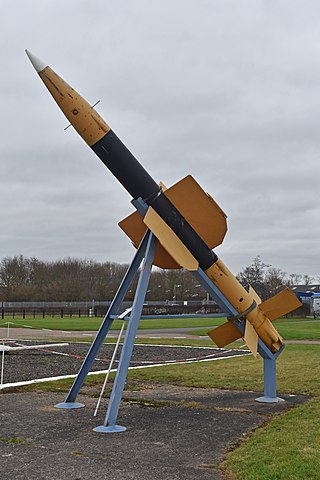
Seaslug was a first-generation surface-to-air missile designed by Armstrong Whitworth for use by the Royal Navy. Tracing its history as far back as 1943's LOPGAP design, it came into operational service in 1961 and was still in use at the time of the Falklands War in 1982.

The M270 Multiple Launch Rocket System is an American armored self-propelled multiple launch rocket system.

The Oerlikon/Martin Marietta air defense anti-tank system is a dual-purpose short range surface-to-air and anti-tank missile system based on the M113A2 vehicle. The ADATS missile is a laser-guided supersonic missile with a range of 10 kilometers, with an electro-optical sensor with TV and forward looking infrared (FLIR). The carrying vehicle also has a search radar with an effective range of over 25 kilometers.

The Integrated Guided Missile Development Programme (IGMDP) was an Indian Ministry of Defence programme for the research and development of the comprehensive range of missiles. The programme was managed by the Defence Research and Development Organisation (DRDO) and Ordnance Factories Board in partnership with other Indian government political organisations. The project started in 1982–83 under the leadership of Abdul Kalam who oversaw its ending in 2008 after these strategic missiles were successfully developed.
Trishul is a low-level quick-reaction short range surface-to-air missile developed in India by Defence Research and Development Organisation (DRDO) as part of the Integrated Guided Missile Development Programme (IGMDP). It can also be used as an anti-sea skimmer from naval ship against low flying missile, attack helicopter and aircraft.
A surface-to-surface missile (SSM) or ground-to-ground missile (GGM) is a missile designed to be launched from the ground or the sea and strike targets on land or at sea. They may be fired from hand-held or vehicle mounted devices, from fixed installations, or from a ship. They are often powered by a rocket engine or sometimes fired by an explosive charge, since the launching platform is typically stationary or moving slowly. They usually have fins and/or wings for lift and stability, although hyper-velocity or short-ranged missiles may use body lift or fly a ballistic trajectory. The V-1 flying bomb was the first operational surface-to-surface missile.

The Raytheon MIM-23 HAWK is an American medium-range surface-to-air missile. It was designed to be a much more mobile counterpart to the MIM-14 Nike Hercules, trading off range and altitude capability for a much smaller size and weight. Its low-level performance was greatly improved over Nike through the adoption of new radars and a continuous wave semi-active radar homing guidance system. It entered service with the US Army in 1959.
The Hsiung Feng IIE is a surface-to-surface land-attack cruise missile system developed by the National Chung-Shan Institute of Science and Technology (NCSIST) in Taiwan.
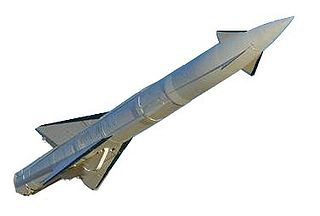
The Roland is a Franco-German mobile short-range surface-to-air missile (SAM) system. The Roland was also purchased by the U.S. Army as one of very few foreign SAM systems.
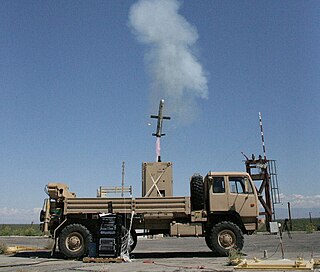
The Non-Line of Sight Launch System (NLOS-LS) was a self-contained missile launcher system that was under development by NETFIRES LLC, a partnership between Lockheed Martin and Raytheon. Each Container Launch Unit (CLU) holds 15 missiles, and a self-locating networked communications system. CLUs can be linked for coordinated launching, with the missiles fired and controlled remotely via autonomous vertical launch. The weapon is roughly 2 metres tall.

The Otomat is an anti-ship and coastal defence missile developed by the Italian company Oto Melara jointly with Matra and now made by MBDA. The name comes, for the first versions, from the name of the two builders and, for the later versions, Teseo, from the Italian word for Theseus. The MILAS variant is an anti-submarine missile. In its latest version Mk/2E purchased by the Italian Navy is a medium range anti-ship missile and a ground attack missile.

The Sky Bow, or Tien Kung, are a series of surface-to-air anti-ballistic missile and anti-aircraft defense systems developed by Taiwan. The TK-2 and TK-3 are in service with the Military of the Republic of China.
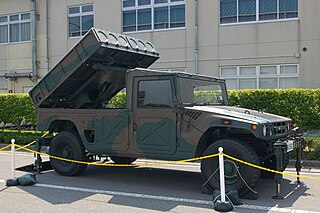
The Type 96 Multi-Purpose Missile System (96式多目的誘導弾システム) is an Anti-tank/Landing craft missile used by the JGSDF. It is the first Japanese missile system that uses a complete digitally controlled interface.

ALAS is a Serbian long-range multipurpose wire guided missile system developed by the private company EdePro and the state-owned Yugoimport SDPR. The ALAS missile system was developed primarily for missions against tanks, armored vehicles, fortifications, command posts, low-flying helicopters, coastal ships, industrial facilities and bridges. It can be deployed by any suitable platform including helicopters, armored vehicles, small ships and infantry. The guidance system is based on video/infrared technology, with the missile connected to the launcher by a fiber-optic cable. The ALAS flies at low altitude and has small radar and infrared (heat) signatures due to using a turbofan motor instead of a turbojet. In recent years, the ALAS platform has found a secondary use as a UAV.

HJ-10 is a Chinese ground-launched anti-tank missile developed by Norinco. It has a tandem high-explosive anti-tank (HEAT) warhead, that may penetrate 1,400 mm (55

FOG-MPM(Fiber Optics Guided Multiple Purpose Missile) is a missile built by the Brazilian company Avibras. Its range is about 60 km. The weight is about 34 kg. Its main use is as an anti-tank, anti-fortification and anti-helicopter missile. FOG-MPM is guided by optical fiber technology. The FOG-MPM is very flexible, can be launched from ground vehicles (Astros II MLRS), ships and helicopters, and is immune to electronic measures.

A precision-guided munition is a guided munition intended to precisely hit a specific target, to minimize collateral damage and increase lethality against intended targets. During the First Gulf War guided munitions accounted for only 9% of weapons fired, but accounted for 75% of all successful hits. Despite guided weapons generally being used on more difficult targets, they were still 35 times more likely to destroy their targets per weapon dropped.
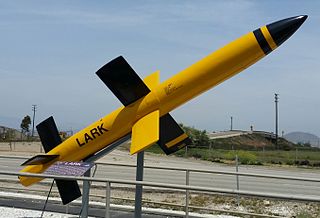
The SAM-N-2 Lark project was a solid-fuel boosted, liquid-fueled surface-to-air missile developed by the United States Navy to meet the kamikaze threat. It was developed as a crash program to introduce a medium-range defensive layer that would attack targets between the long-range combat air patrols and short-range anti-aircraft artillery. This produced a design with roughly 30 miles (48 km) maximum range and subsonic performance, suitable for attacks against Japanese aircraft.

CM501G is a Chinese land attack missile first revealed during the 9th Zhuhai Airshow held in November 2012. Developed by China Aerospace Science and Industry Corporation (CASIC), CM-501G is also available in air and ship launched versions upon customers' requests, but only the land-based version made its public debut at the airshow.
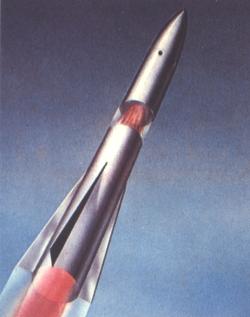
Project Wizard was a Cold War-era anti-ballistic missile system to defend against short and medium-range threats of the V-2 rocket type. It was contracted by the US Army Air Force in March 1946 with the University of Michigan's Aeronautical Research Center (MARC). A similar effort, Project Thumper, started at General Electric.